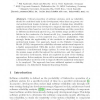Free Online Productivity Tools
i2Speak
i2Symbol
i2OCR
iTex2Img
iWeb2Print
iWeb2Shot
i2Type
iPdf2Split
iPdf2Merge
i2Bopomofo
i2Arabic
i2Style
i2Image
i2PDF
iLatex2Rtf
Sci2ools
QOSA
2010
Springer
2010
Springer
Parameterized Reliability Prediction for Component-Based Software Architectures
Critical properties of software systems, such as reliability, should be considered early in the development, when they can govern crucial architectural design decisions. A number of design-time reliabilityanalysis methods has been developed to support this task. However, the methods are often based on very low-level formalisms, and the connection to different architectural aspects (e.g., the system usage profile) is either hidden in the constructs of a formal model (e.g., transition probabilities of a Markov chain), or even neglected (e.g., resource availability). This strongly limits the applicability of the methods to effectively support architectural design. Our approach, based on the Palladio Component Model (PCM), integrates the reliability-relevant architectural aspects in a highly parameterized UML-like model, which allows for transparent evaluation of architectural design options. It covers the propagation of the system usage profile throughout the architecture, and the imp...
| Added | 30 Aug 2010 |
| Updated | 30 Aug 2010 |
| Type | Conference |
| Year | 2010 |
| Where | QOSA |
| Authors | Franz Brosch, Heiko Koziolek, Barbora Buhnova, Ralf Reussner |
Comments (0)

